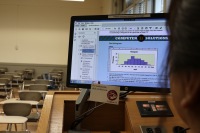By Marianys Marte

Fordham professors adapt to the changing technological climate in the classroom. (Owen Corrigan / The Fordham Ram)
Changing technology and its massive influence on our society has forced the collegiate world to change its methods of education for the up-and-coming generation. As a result, students at Fordham have called for college classrooms to adapt to the current technology landscape. Many Fordham professors have excelled in the face of this demand with the help of some university resources while many others have fallen short of the mark.
The Faculty Technology Center is available for professors to use to their advantage and learn how to incorporate new and existing technology into their classrooms.
Shawn Hill, instructional technologist at the Faculty Technology Center, said it is important for faculty to be proficient at using new technology. The Center offers one-on-one mentoring and tailors their level of support to the needs of the faculty member.
“At minimum it is important for professors to be tech-savvy in order to simply navigate the day-to-day university systems,” said Hill. “In addition, everyone at the university – students, faculty and admin – all benefit when we look beyond what is simply required to the many exciting technology tools out there that can enhance teaching and learning.”
Hill said the center offers an array of training to accommodate different needs of the faculty.
“We offer webinars, group training, departmental presentations, one-on-one mentoring, and call/email support,” said Hill. “Our goal is to offer a flexible menu of ways in which a member of the faculty can get the training she needs.”
Some faculty incorporate an online publishing platform called Scalar and a program called Qualtrics, which is a creation tool for quizzes, surveys and voting in elections.
“Fordham faculty in departments and programs as diverse as Medieval Studies, Modern Languages, Religion, Jewish Studies, Sociology and Physics, to cite only a few examples, are using innovative technology to enhance both their own scholarship and the classroom experience,” said Hill.
For some professors here at Fordham, technology is best used in the classroom when its potential is maximized.
“It’s not just knowing how to use different technologies or platforms, but knowing about the norms in those spaces and how to use them to greater effect,” said Jesse Baldwin-Philippi, Ph.D., communications professor.
Some students feel professors can use technology better in the classroom.
“Often times professors will offer some extra credit to a student who volunteers to work the screen and computer for them.” Lilibeth Ramos Flores, FCRH ’17. “It’s kind of sad that in a school that claims to be state-of-the-art, a lot of professors aren’t exactly tech-savvy.”
Technology is ever-changing and professors, as well as students, keep up with it in order to be tech-savvy.
“Most of my professors have done a good job incorporating technology into the curriculum,” said Alexis Leeds, FCRH ’18. “I’ve had professors who use Facebook groups or Twitter to get the class engaged, which I think is a really good way to get people to participate.”
Universities first began digitizing the classroom once Tim Berners-Lee introduced the World Wide Web in the 1990s.
“I’m online all the time. Either from my smartphone or anytime I’m near a computer. I keep in touch. That enables me to be on the cutting edge of developments,” said Paul Levinson, Ph.D., communications professor.
Some departments depend on technology in the classroom more than others.
“In the Communications and Media Studies department, most of the classes our professors teach have to do with the digital age in one way or another,” said Dr. Levinson.
“You can’t study media and culture without understanding and having access to new technologies.”
Other students feel that technology allows students with different approaches to learning to benefit in the classroom.
“It’s important to integrate technology in the classroom,” said Addiel Sanchez, FCRH ’17.
“It allows for a different learning method either through a more visual approach or more interactive, which may benefit other people’s learning style.”

Professors react as educational methods change due to ever evolving technology. (Owen Corrigan / The Fordham Ram)
